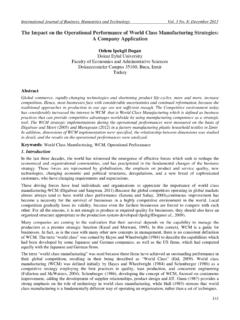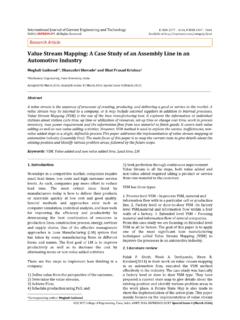Transcription of New Product Development - Engineering
1 103 CHAPTER 5 New Product DevelopmentOverviewThis chapter addresses four key issues: (1) early supply management and supplier involve-ment; (2) the process of designing and developing new products, with emphasis on supply management s role in the process; (3) several approaches to increasing supply management s role in the new Product Development process; and (4) a description of supply management professionals who interface successfully with engineers during the new Product Development firms excel at a crucial triad of activities: new Product Development , the design of the required production process, and Development of the optimal supply chain. This chapter addresses the first member of this triad. Rapid changes in technology, the emergence of global industrial and consumer mar-kets, increasing market fragmentation and Product differentiation, and the increasing options for developing and producing products have increased the pressure on all firms to more effectively and efficiently develop new products.
2 1 In many progressive firms, the design of new products is conducted by a team representing a number of functional areas. Marketing, Product planning, design Engineering , reliability Engineering , supply management, manufacturing Engineering , quality, finance, field support, and, frequently, carefully selected suppliers and customers are involved, as appropriate. If effectively done, new Product Development (NPD) can be a source of competitive advantage for a firm and a competitive strategy for the internal and external partnerships of the supply evidence indicates that the Development of new products by such cross-functional teams and the use of concurrent engineering3 have the potential of signifi-cantly improving three key objectives: time to market, quality, and total The turnaround of many troubled manufacturers during the past decade was the result of replacing departmental walls with teamwork among those who should be part of the design process.
3 Supply management professionals and carefully selected suppliers are 10311/14/11 3:19:53 PM104 | Chapter Five moving to earlier involvement in the new Product Development process because of the important contributions they can make in the areas of quality, cost, and timely market availability. This early involvement commonly is referred to as early supply management involvement and early supplier involvement (ESI). German authorities Arnold and Essig conclude that by involving supply management and suppliers in the simultaneous engi-neering process (as members of cross functional teams) at an early stage, R&D gets the chance to increase In fact, early supply management involvement helps to shorten Engineering time and increase Engineering quality.
4 5 The lack of effective, cooperative teamwork among the functions just noted frequently has been accompanied by quality problems, cost overruns, forgone all-in-cost savings,6 major scheduling problems, and new products that are late to enter the marketplace. Further, early recognition of problems is difficult or impossible in the absence of cooperative teamwork. Extensive redesign, rework, and retrofit operations are common when a company is oper-ating in the traditional functional mode. Ultimately, the absence of teamwork results in products that are a continuing burden to the firm s long-term overruns and forgone cost savings frequently result when the designers (or the design team) fail to consider the supply base s design, manufacturing, quality, and cost capabilities.
5 For example, during the early 1980s, design engineers at General Electric s Jet Engine Division frequently designed materials to be purchased from outside suppliers under the mistaken belief that the outside suppliers had the same manufacturing and pro-cess capabilities as GE. In fact, this was not the case; the outside suppliers frequently did not have the same equipment, processes, and quality capabilities. The results were cost growth and schedule slippages as the suppliers, using a trial-and-error process, attempted to meet GE s specifications. Frequently, it became apparent that those specifications could not be met and that a costly and time-consuming process of reengineering would be similar example of costs resulting from the failure to consider supply implications during design involves IBM.
6 In 1993, IBM s PC units sales were just over $8 billion, with earnings of about $200 million ( ). By contrast, Compaq s profits were $462 million on sales of $ billion ( ). According to Business Week, At least one reason .. seems clear, IBM still does not use common parts across its Product families. Another contribu-tor to lower profits was IBM s failure to shift away from pricey Japanese components as the value of the yen It was noted that IBM recognized that its supply management system had been the source of significant cost overruns and forgone dollar savings. In 1994, that recognition resulted in the appointment of a new Chief Procurement Officer: Mr. Gene Richter. Under Richter, three-time Purchasing Man of the Year, IBM procurement has undergone an incredible transformation and is now approaching World Class problems frequently result from late delivery of required parts.
7 For exam-ple, earnings at Apple Computer fell nearly 30% in the third quarter of 1999, largely as a 10411/14/11 3:19:53 PMNew Product Development | 105result of supply shortages. Apple received only 45% of the G4 chips its suppliers originally had promised. This, in turn, led to significant reductions in the sales of Apple s Power Mac G4 When supply considerations are not addressed during new Product Development , unique nonstandard components may be specified. Those components fre-quently require longer lead times than do standard items. The use of nonstandard items often leads to the inability of the manufacturer to react quickly to changes in market demand, frequently resulting in lost sales. To reduce reaction time to changes in demand, firms are replacing unique components with standard commodity ones.
8 In addition to being more readily available, commodity components tend to be far less expensive than the unique items they global marketplace and global competition, coupled with advanced communica-tion systems, computers, and sophisticated software, have generated an environment where time to market and first to market have significant competitive advantages. Clearly, the need to reduce Development time has forced companies to look for new methods to com-pete. The use of supply professionals and suppliers earlier in the Product Development cycle is a key way to reduce time to market. The advantages of an integrated approach to new Product Development no longer can be the early 1990s, the Chrysler Viper went from concept to production in 36 months, in contrast to an industry norm of 60 months.
9 Chrysler did not achieve that goal by itself; it got a lot of support from its suppliers. They were as much a part of the Viper team as anyone .. suppliers are an integral part of the team, said Dave Swietlik, the man in charge of procurement for the Viper program. Their processes drive design. 11 When a cross-functional team has the responsibility for the Development of new prod-ucts, a concurrent approach to the myriad of tasks involved is taken. This avoids the tra-ditional (and time-consuming) passage of a project from concept Development , to design, to manufacturing Engineering , to supply management, to manufacturing, to marketing, to field support. That sequential approach requires even more time and personnel resources when changes have to be made in the Product s design.
10 The cross-functional team uses a concurrent approach in which the team members work together and collabo-rate throughout the Design Process12 Design is the progression of an abstract notion or idea to something that has a function and a fixed form. The desired levels of quality and reliability must be engineered in dur-ing the design phase of the new Product . Suppliers must have access to Product design as early as humanly possible in the design process to assure optimal use of any special skills or processes they can contribute. 13 The design stage is also the optimum point at which the 10511/14/11 3:19:53 PM106 | Chapter Five vast majority of the cost of making an item can be reduced or controlled. If costs are not minimized during the design stage, excessive cost may be built in permanently, resulting in expensive, possibly noncompetitive, products that fail to realize their profit potential.








